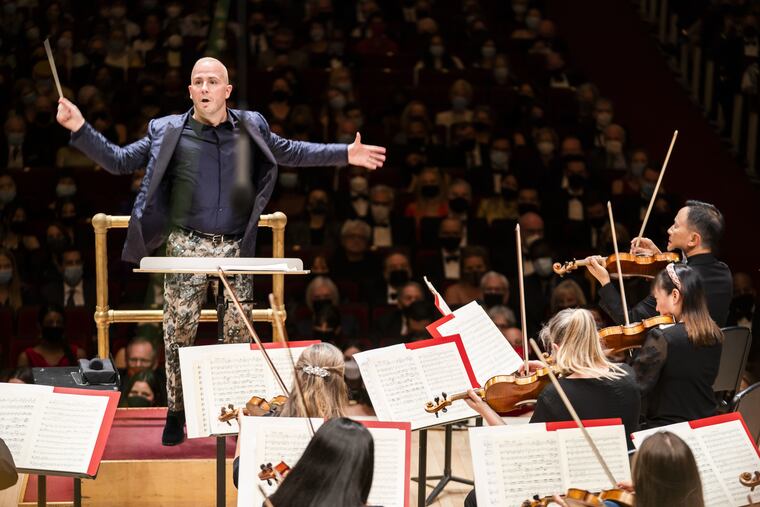With a visit by the Philadelphia Orchestra, Carnegie Hall’s main auditorium reopens after a long silence
Star pianist Yuja Wang was soloist for the orchestra's Carnegie appearance.

No matter how much one might want to turn back the clock to times prior to March 2020, the very different classical music world emerging from the pandemic was apparent at the Philadelphia Orchestra’s reopening of Carnegie Hall on Wednesday — often for the better. But not always.
The famous auditorium was packed. Ushers insisted that masks covered all noses. The orchestra sounded better than ever in the Carnegie acoustics. The program checked many boxes, not just displaying the orchestra’s luminous sound but also its new-music endeavors. The world was invited to listen — via live streaming from WQXR radio, websites of the Philadelphia Orchestra and Carnegie Hall, as well as Europe’s Medici.tv.
The audience was welcomed back by Carnegie board president Robert F. Smith and executive and artistic director Clive Gillinson after 572 days of silence, during which the old question of “How do you get to Carnegie Hall?” was answered with “patience, patience, patience.” Now, only a smattering of seats are left for star tenor Jonas Kaufmann on Oct. 9; pianist Lang Lang is sold out on Oct. 12. The Philadelphia Orchestra returns throughout the season with a complete Beethoven orchestral cycle that started Wednesday with the Symphony No. 5.
“What we’ve gained, I hope, is a raised awareness as to how art can be a key to changing our world,” said music director Yannick Nézet-Séguin during the concert. “We can still play Beethoven, but …” He named the two new works on the program that reflect different levels of social awareness. Philosophically, one couldn’t agree more.
And yet, questionable decisions on Wednesday left you worried about waves of the future. Was the concert concerned with making statements more than making music? In contrast, the San Francisco Symphony’s enviable opening under Esa-Pekka Salonen went out of its comfort zone with Gaia, a major concert work by jazz great Wayne Shorter, with a sympathetic all-American program (heard on a radio broadcast) built around it.
The indisputable high point in the all-over-the-place Carnegie concert was Shostakovich’s modest, cheeky Piano Concerto No. 2 played by Yuja Wang. Shostakovich’s later music was often a series of sardonic masks that seem to take jabs at 1950s Soviet Union, but not specifically enough to say what was being satirized. The concerto delights in withholding its inner depths, as if to say “You figure it out!” Pianist Wang found beauty and detail in the masks themselves. The high-velocity brilliance of the performance revealed ingenuity and hidden poetry in the music, with a happy outcome that could be described as Ravel on Ritalin.
But then? What was Bernstein’s Candide Overture doing stuck in the middle of the program? Didn’t Valerie Coleman’s lovably rousing Seven O’Clock Shout touch that celebratory base with greater specificity in its homage to the front-line health workers? Though played often since its 2020 premiere by the orchestra, Coleman’s swaggering, confident music — with its vocal cheering and pots-and-pans percussion — shows no signs of wearing out its welcome.
Why was Iman Habibi’s orchestral showpiece Jeder Baum spricht (Every Tree Speaks) robbed of applause when the orchestra dove straight into the Beethoven symphony? Habibi’s music (whose program notes reference climate change) exists in a different coloristic world that — though attractive and even intoxicating — doesn’t meld well with Beethoven’s.
Though Nézet-Séguin developed a clear interpretive vision in a Beethoven cycle with the Chamber Orchestra of Europe in Baden Baden over the summer, Wednesday’s Beethoven proceeded similarly but grew indecisive, with a clean, classical concept interrupted by slowing to achieve something more monumental, and seemingly belonged to a different kind of performance.
On the plus side: Listeners not used to hearing Nézet-Séguin in Philadelphia remark at how loud the orchestra can get. Beethoven’s final movement went well beyond what was typical, which suited the pent-up energy heard in so many re-openings. It’s as if the Philadelphia Orchestra was trying to out shout all of the other great orchestras in the country. And it can.
Now … can somebody please explain the enigmatic patterns on Nézet-Séguin’s avant-garde trousers?